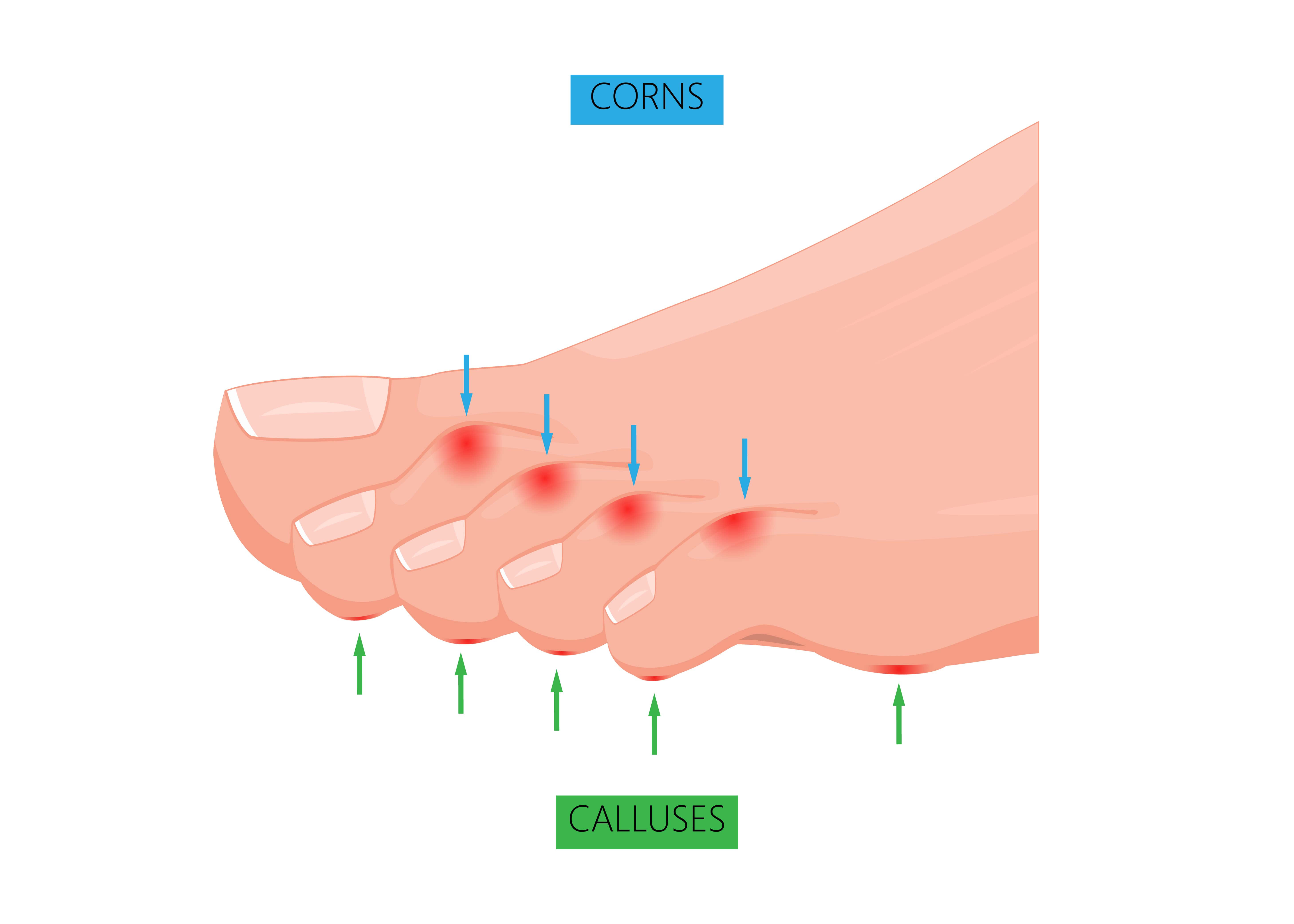What are persistent corns?
Corns (雞眼) are small, hard areas of skin that typically develop on the feet in response to pressure or friction. They often occur in bony areas or where the skin rubs against the inside of a shoe. Persistent corns are those that remain over a long period of time, causing discomfort and sometimes pain when walking or wearing shoes.
Persistent corns are usually caused by repeated pressure or friction on the same foot spot. This can occur due to poorly fitting shoes, walking or standing for long periods, or abnormal gait. Certain foot deformities, such as hammertoe or bunion, can also lead to the formation of corns.
What are calluses?
Calluses(老繭) are larger patches of tough, thickened skin that often develop on the hands or feet. They are the body's way of protecting the skin from repeated friction or pressure. Unlike corns, calluses are usually not painful.
Calluses form for similar reasons to corns – repeated friction or pressure. They commonly occur in people who play musical instruments, work with their hands, or wear high heels. Those with certain foot abnormalities or gait issues may also develop calluses on their feet.

Difference between persistent corns and calluses?
While both corns and calluses are caused by friction or pressure, they have some distinct differences. Corns are smaller, more defined, and often occur on non-weight-bearing parts of the foot. They can be painful when pressed. Calluses, on the other hand, are larger, less defined. Corns and calluses can mostly be found on your feet, toes and hands. Corns and calluses are typically not painful, but in some cases, they can be tender or painful.
Home remedies for calluses and corns
For corns and callus that have no underlying problems, you can try the below suggestions to clear up:
Soak it with water
Use water to soak your feet and hands to remove the thickened skin easily.
Make the thickened skin thinner
After you have softened the affected skin, rub the callus and corn with washcloth, nail file, pumice stone or emery board. If you have diabetes, don't use a pumice stone.
Padding
Silicone or moleskin pads can be applied directly to corns or calluses to reduce friction and pressure on the affected area, providing some relief. These can be found in most drugstores.
Keep your skin moisturised
Lotions and creams designed for dry skin can be beneficial in treating calluses. Look for products containing urea or lactic acid, which can help soften and moisturise the thickened skin.
Wear comfortable socks and shoes
One of the most effective treatment options for both corns and calluses involves addressing the root cause of the problem. For many people, this means re-evaluating their footwear. Shoes that are too tight, loose, or lack appropriate cushioning can all contribute to the development of corns and calluses. Opting for shoes with a broader toe box and good arch support can alleviate the problem.
Don’t walk barefoot
Especially in public places, as there is no protection for your feet.
Avoid wearing high heels or tight shoes
As it can cause pressure to your foot.
Rest your feet more
Don’t walk or stand for a long time.
Over-the-counter remedies can help soften calluses, making them easier to remove with a pumice stone or foot file. For persistent calluses, medical treatment may be necessary. A doctor or podiatrist can safely remove the corn, prescribe stronger treatments, or recommend orthotics.
Corns and calluses treatment
Treating calluses often involves removing the source of pressure or friction. Below is what you can do to relieve calluses:
Cutting away excess skin
Visit a doctor to pare down the thickened skin or trim a large corn with a scalpel. Don’t try this without consulting a doctor.
Change your hand and footwear
Wear gloves for your hands, thick socks and comfortable shoes for your feet.
Medication
In some cases, prescription creams containing stronger salicylic acid or urea concentrations may be prescribed.
Orthotic Devices
Custom-made orthotic devices may be recommended if an underlying foot abnormality causes corns or calluses. These devices can help redistribute pressure on the feet when you walk, preventing corns and calluses from forming.
Surgery
If other treatment options are ineffective and a bone structure problem causes the corns or calluses, surgery might be considered.
When to see a doctor?
While many corns and calluses can be managed at home, it's important to see a doctor under these conditions if:
- Corns and callus persist for more than 3 weeks
- Cause discomfort
- Inflammation exists
- Bleeding
- Skin color changes
- You have diabetes
- You have heart disease or poor circulation problems, or other conditions that affect the feet should
Please note that while the home remedies mentioned here can help manage symptoms and improve comfort, they may not entirely prevent corns or calluses from reoccurring, particularly if the source of pressure or friction remains. As such, it's important to address the root cause of the problem and make the necessary lifestyle changes. Remember to seek medical advice if you have the accompanying symptoms mentioned above. Your doctor will examine your corns and calluses more thoroughly.
References
- Mayo Clinic. Corns and calluses. 26 Sept 2023 Retrieved from https://www.mayoclinic.org/diseases-conditions/corns-and-calluses/diagnosis-treatment/drc-20355951
- NHS. Corns and calluses. 26 Sept 2023 Retrieved from https://www.nhs.uk/conditions/corns-and-calluses/
- Curalta Foot+Ankle. What to Do About Corns and Calluses on Your Feet. 26 Sept 2023 Retrieved from https://www.passaicfootandankle.com/blog/what-to-do-about-corns-and-calluses-on-your-feet
- Harvard Health Publishing – Harvard Medical School. Calluses and corns. 26 Sept 2023 Retrieved from https://www.health.harvard.edu/pain/calluses-and-corns
 Central General Practice
Central General Practice
 Repulse Bay
Repulse Bay
 Clearwater Bay
Clearwater Bay
 BodyWorX Clinic
BodyWorX Clinic
 Central Specialist Clinic
Central Specialist Clinic
 MindWorX Clinic
MindWorX Clinic
 Partner Clinics
Partner Clinics
 Family Clinic
Family Clinic
 OT&P Annerley Midwives Clinic
OT&P Annerley Midwives Clinic






